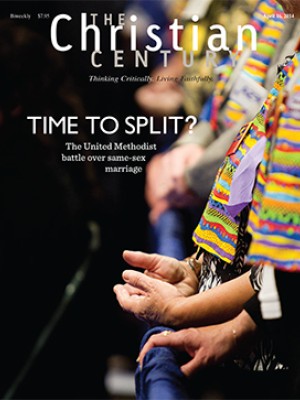Sunday, April 27, 2014: John 20:19-31; 1 Peter 1:3-9
The story of Thomas in John 20, which may have been the book’s original conclusion, salutes those who “have not seen and yet have come to believe.” First Peter offers a similar commendation: “Although you have not seen him, you love him.”
These texts offer encouragement for later generations of Christians. How do people who didn’t see Jesus on earth come to faith? It’s a critical question for John’s Gospel—and for the church. John is clear that he writes in order to help readers come to believe that “Jesus is the Messiah, the Son of God, and that through believing you may have life in his name.” Separated in time and space from the resurrected Jesus, we depend on what others say. So our belief is somehow more special, indeed “blessed” (20:29).
Read our latest issue or browse back issues.
Protestantism’s emphasis on justification by faith intensifies this concern for how we come to believe without seeing the nail marks or putting our hands in Jesus’ side. In some branches of this tradition, faith can become a monumental existential exercise—so much that “faith” can even resemble a “work.” In this context, we can understand and even empathize with Thomas’s refusal to accept the witness of the other disciples. Still, it can be hard for him to be a model for us.
Thomas wants to see and touch for himself—and behold! When Jesus appears to him and tells him to go ahead and experience the reality of his wounded body, Thomas discerns what neither Mary Magdalene nor the other disciples did in the passage just before: that Jesus is both “my Lord and my God.” Thomas’s determination to see for himself leads to a critical theological insight, an epiphany.
I wonder if we need to explore more seriously Thomas’s approach to faith. We sing “We Walk by Faith and Not by Sight,” but what is wrong with walking by both?
In a number of congregations, I have been blessed to be able to serve with people who are both scientists and Christians. Personally, I reserve the right to be skeptical of scientists. Growing up, I played with a toy brontosaurus. Now we are told that the brontosaurus was actually an apatosaurus, that Fred Flintstone ate apato-burgers. I also learned about the solar system and its nine planets. Now Pluto is just a planetoid, whatever that is. Why should I ever trust scientists?
Of course, such musings depend on a fundamental misunderstanding of science. It may be appropriate to fifth-grade exams, where there is one right answer. But it’s inappropriate to adult citizenship in a complex world, in which science is less fixed because it is constantly refining our understanding of the beauty of God’s earth. While people sometimes set science and religion in opposition, the scientists I’ve been blessed to learn from have been great models of faith. Their Thomas-like commitment to seeing and touching—to the wise use of human perception—allows them to express their faith clearly.
In my experience, the complex angst sometimes associated with faith seems almost foreign to nurses, doctors, researchers, and science teachers. A theologian friend of mine goes to conferences on science and religion, and he observes that the scientists have an easier time talking about faith. The theologians, he notes, seem anxious or embarrassed about trying to bring science and religion together in some kind of dialogue without carefully enunciated epistemological caveats. The scientists, by contrast, are quite ready to speak about the created order of God as both faithful Christians and practicing scientists. They are comfortable and confident as they combine seeing and believing. I have also found that, on the whole, scientists who are Christians are quite likely to experience the peace that Jesus bestows on his followers in John. The rejoicing of 1 Peter is present in their lives, even as they too experience difficult times.
I am decades away from my last science course, but I marvel at how the habits and practices of scientists give them the freedom to speak confidently about faith. As I have listened in Bible studies and in informal conversations, I have come to respect their profound awareness of the limitations of human knowledge and the role of the larger scientific community. Medical professionals, for example, recognize just how little they sometimes can actually know about a person’s condition. Sometimes best guesses come into play, based on what their colleagues observe in other patients. “Knowing” thus involves personal observation, communal wisdom, and respecting the limits of what can be known in the moment. Faith, similarly, tends to involve all three.
Thomas saw with his own eyes and believed. And he became aware of the central mystery of the Gospel of John: how the Word of God “became flesh and lived among us” (1:14). The scientists I have known also have a wonderful respect for mystery. They know what they know and don’t know, and when they approach a boundary between the two, they gaze into the unknown with profound respect and awe. Walking both by faith and by sight, they teach us how to sing “For the Beauty of the Earth.”






